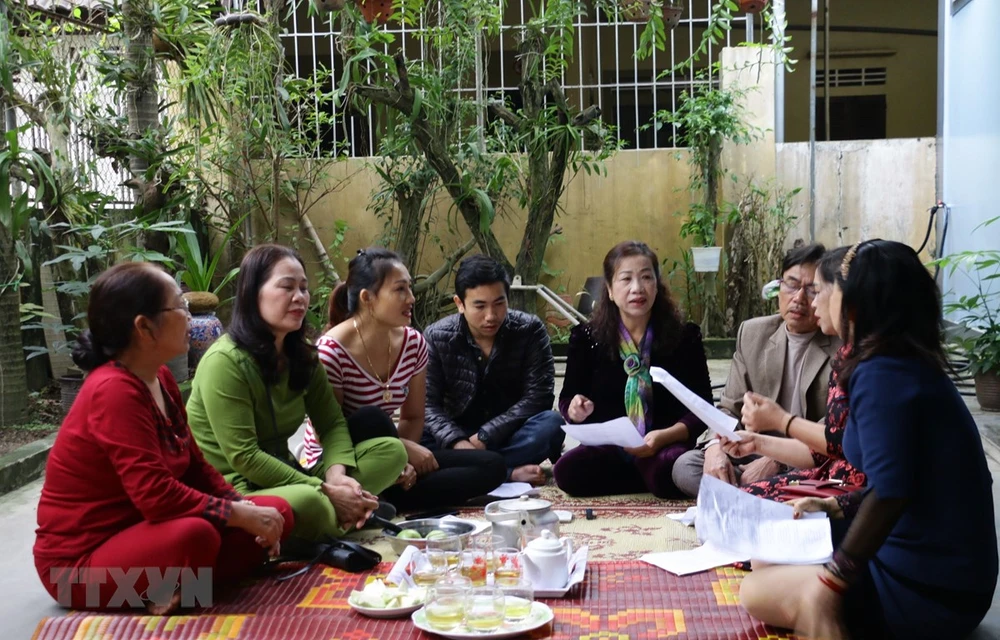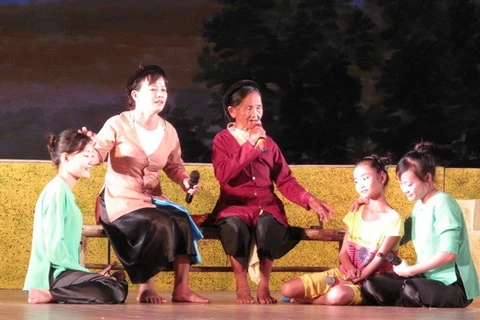
Hanoi (VNA) - Vi - Giam folk singing is simple but profound, creating a particular language to reflect the rich and diverse life of the people of the Nghe region in north central Vietnam.
Among Vietnamese folk songs, there are few types of folk songs closely associated with the dialect such as Vi - Giam folk songs of the Nghe Tinh (Nghe An and Ha Tinh) region.
The Vi - Giam song is sung in a back-and-forth style while working, unaccompanied by musical instruments. The singing reflects the work, cultural life and feelings of the local people.
Vi - Giam folk singing was officially recognised by the United Nations Educational, Scientific and Cultural Organisation (UNESCO) as part of the intangible cultural heritage of humanity at the 9th session of its Inter-governmental Committee for the Safeguarding of the Intangible Cultural Heritage in Paris on November 27, 2014.
Vi - Giam folk singing has an extremely strong vitality. It not only existed in the past but has constantly developed in the hearts of people in the Nghe Tinh people. That’s why people in the region have a famous saying, “only when people here no longer have their voice will Vi - Giam folk singing be lost.”
Long-lasting history of Vi - Giam folk songs
Most folklore researchers agree that Vi - Giam folk songs, like many other folk songs in the northern delta, are originated from the working and daily life of the local people, therefore they have a long-lasting history of establishment and development.
According to various sources of scholars, researchers, collectors, musicians, during the 17th and 18th centuries, Vi – Giam folk songs were very developed and became a popular form of folk performance in the Nghe An and Ha Tinh communities, attracting the participation of different social classes.
From the 19th century to the middle of the 20th century, Vi – Giam folk songs were widely popular and formed some centers with the participation of Confucian scholars and intellectuals such as Phan Boi Chau, Vuong Thuc Quy, Bui Chinh Lo, Dang Van Ba, Nguyen Thuc Canh and Le Vo.
Experiencing ups and downs of history, Vi – Giam folk songs still prove their durable vitality and attract people in modern society. The folk genre is still preserved and fostered by local people of Nghe An and Ha Tinh.
Unique features of Vi – Giam folk songs
Vi - Giam singing is a kind of folk poets. It is easy to remember and creative.
The folk music is a repartee singing while working. There are an estimated 15 tunes of Vi and eight airs of Giam, reflecting the work, cultural life and feelings of the residents in the central coastal provinces.
It is popular in nearly 260 villages across the central provinces of Nghe An and Ha Tinh. The two provinces have 51 singing clubs with over 800 vocalists, many of whom are actively preserving the folk music.
Unlike some other folk songs that are closely associated with a space and time of performance, especially in festivals, Nghe-Tinh folk songs in general and Vi – Giam folk songs in particular are sung by local people almost year round.
Apart from singing the folk art form at festivals or in the stage, they sing Vi – Giam folk songs while doing fields, collecting wood in forests, or rowing on river.
Thanks to its unique value, Vi – Giam folk song was recognised by UNESCO as part of the intangible cultural heritage of humanity. The international recognition toward the unique folk art has helped the local community and authorities to be more aware of preserving, educating and encouraging the young generation to learn and take part in performances of the art in order to protect and promote the intangible cultural heritage in a sustainable manner.
Preserving and promoting cultural heritage value
Nghe An and Ha Tinh provinces have spared no effort to preserve and promote the value of Vi – Giam folk songs through various activities such as collecting, researching, popularising, promoting, publishing and honouring artisans.
 Singing practice of the Vi - Giam folk song club of Van Dien commune, Nam Dan district, Nghe An province. (Photo: VNA)
Singing practice of the Vi - Giam folk song club of Van Dien commune, Nam Dan district, Nghe An province. (Photo: VNA)
Besides, they have supported the establishment of folk clubs, organised festivals, contests and performances while piloting to include the folk singing to schools’ curriculum and teaching folk songs in mass media.
The number of Vi – Giam folk song clubs in districts, cities and towns has been increasing, from 92 clubs in 15 districts and cities with a total of nearly 2,000 members in 2015 to 120 clubs in 20 districts and cities with a total of more than 2,000 members of all ages and various occupations.
In addition, the clubs have been set up in Hanoi and southern provinces./.























